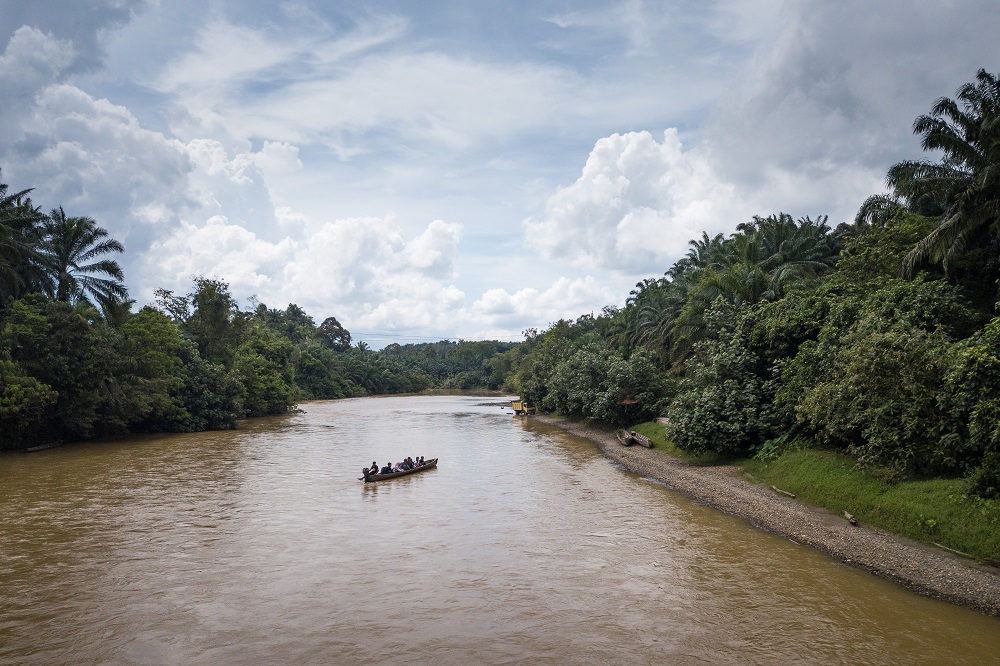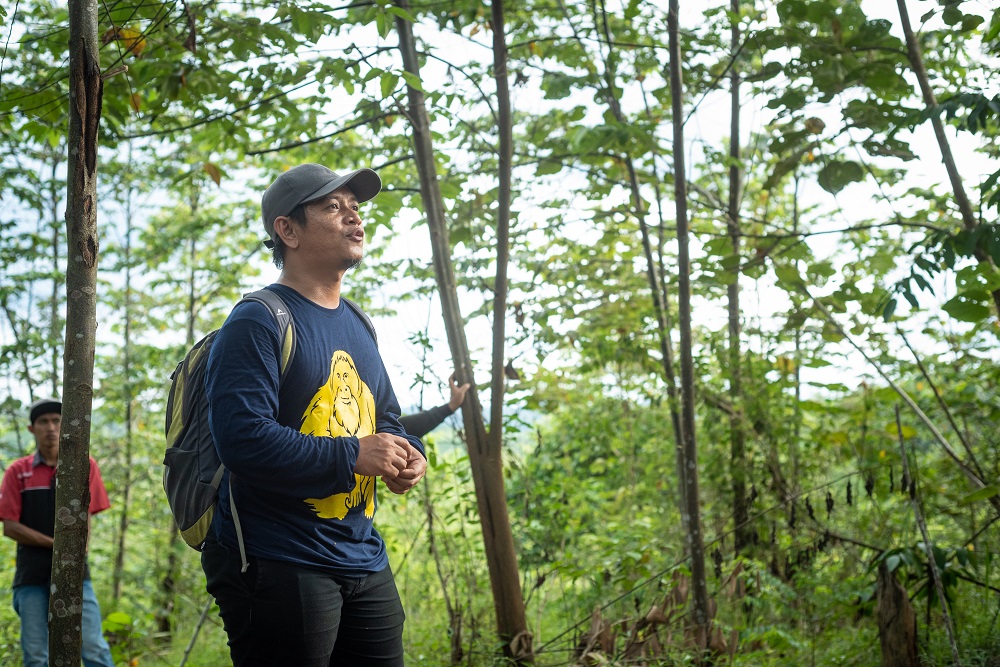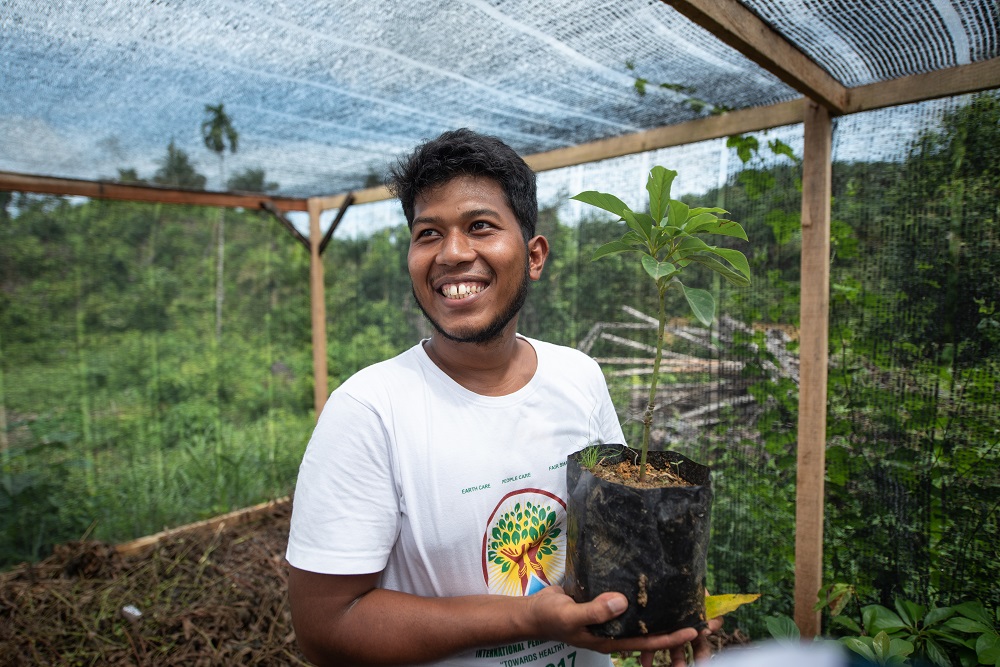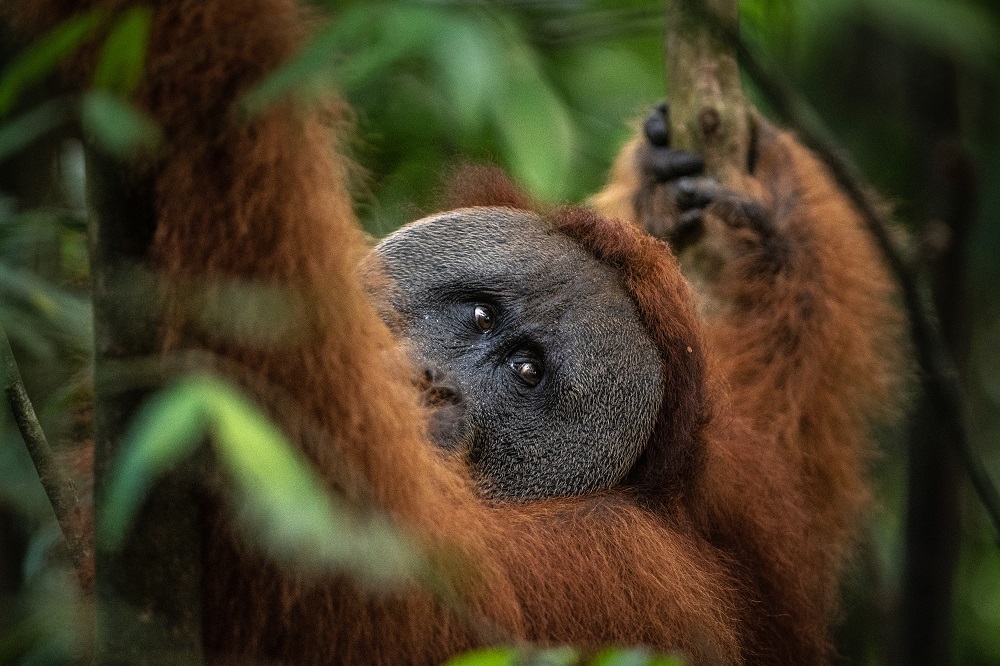Arriving at Bukit Mas felt like an adventure. In the still, heavy heat of a Sumatran afternoon, I picked my way across the stony riverbed to where the water lapped against the land. My sandals filling with water, I climbed into the getek, a traditional riverboat, relishing the slight breeze as the driver steered it into the deepest part of the river. The riverbank on the other side is steep, and the vegetation growing there hides Bukit Mas from view. I scrambled up, slipping slightly in my wet shoes, and emerged to see the welcoming smiles of my hosts, the fantastic restoration staff from Orangutan Information Centre (OIC).

Crossing the river. Photo credit Andrew Walmsley.
Bukit Mas is a 100-hectare site in North Sumatra. Formerly an oil palm plantation, it is now in the hands of conservationists and permaculture experts. The oil palm trees have been cut down, and work is underway to turn this piece of land into something wonderful. Using funds from the Lush #SOSSumatra campaign, SOS was able to buy the land early in 2018 on behalf of our sister charity, the Indonesian NGO Orangutan Information Centre (OIC).
Having seen photographs of the site before flying out to Sumatra, I thought I knew what to expect from my visit there. I imagined picking my way through the stumps of oil palms and looking at drawings of what would grow there once the land has had more time to recover. I thought it would all feel very far from the vibrancy and diversity of a rainforest full of life. When I got off that getek in October, though, I realised that OIC’s hard work had already given the place an air of paradise. As the heat of the day started to dissipate and the edges of the clouds turned pink, OIC’s restoration manager, Rio, took me for a walk around the 50 hectares of the site set aside for forest restoration.

Rio explains the restoration process. Photo credit Andrew Walmsley.
Bukit Mas means ‘golden hill’, and as we walked around, I could see why. The paths we walked along sloped gently upwards, giving an amazing view over the surrounding forest in the low, late-afternoon sun. Feeling hot and slightly breathless after walking in the humid air, I was grateful for the relative cool provided by the trees already planted at the site – a tangible reminder of one of the many things we gain from forest ecosystems. On one side of the path through the site, Rio pointed out the indigenous tree saplings taking hold where the oil palms used to be.
On the other side, he showed me rows of chillies, aubergines and other vegetables – cash crops for local farmers taking part in OIC’s permaculture training programme. He explained how the farmers are trained to protect their crops from monkeys by planting lemongrass around them – it’s a valuable crop, and the sharp leaves are a natural deterrent for monkeys who might otherwise try their luck. This is one of the many brilliantly simple ways that OIC is using permaculture to ensure that Bukit Mas works in harmony with the wildlife surrounding it.
Sabar, OIC’s permaculture manager, showed me around the permaculture nursery and garden. He explained that the crops are planted in a formation that allows for water and humus to be retained around the roots of the plants, especially important when they’re planted on a slope. He showed us where the team has put perches to encourage wild birds to sit all around the site, aiding seed dispersal with their droppings. In the nursery, patchouli and ylang-ylang plants grow in dense rows, checked regularly by Sabar and the team of local staff he’s training.

Sabar in one of the permaculture nurseries. Photo credit Andrew Walmsley.
As I crossed the river again at the end of my visit, I felt full of hope. The difference OIC has made at Bukit Mas in such a short time had opened my eyes to what’s possible when people are dedicated to making a positive impact. Prior to my visit to Bukit Mas, I had been to see the 360-hectare plot of land SOS is now fundraising to buy. Called Cinta Raja, it is currently an oil palm plantation and a hotspot for human-wildlife conflict – we know of tigers, elephants and orangutans all being displaced or killed at the site in recent months. Standing there now, the forest feels almost close enough to touch, but the oil palm trees and the dry cracked soil form a silent and forbidding barrier.
Our aim in buying this land on behalf of OIC is to ensure that this long, thin strip can be turned back into forest. The 360 hectares will provide a home for orangutans and other wildlife, simultaneously forming a buffer zone between primary forest and agricultural land. This buffer zone will be protected by OIC, greatly reducing the opportunity for incursions into the forest for poaching or palm oil.
Having been to Bukit Mas, I am much better able to envisage this land becoming forest again – the chainsaws taking down the oil palms; the seedlings growing in the nursery and the careful attention of OIC’s wonderful, dedicated staff to ensuring that the land remains a haven for wildlife. I look forward to my first visit to Cinta Raja as a restoration site instead of a palm oil plantation. It’s exciting to know that this is within our reach.

